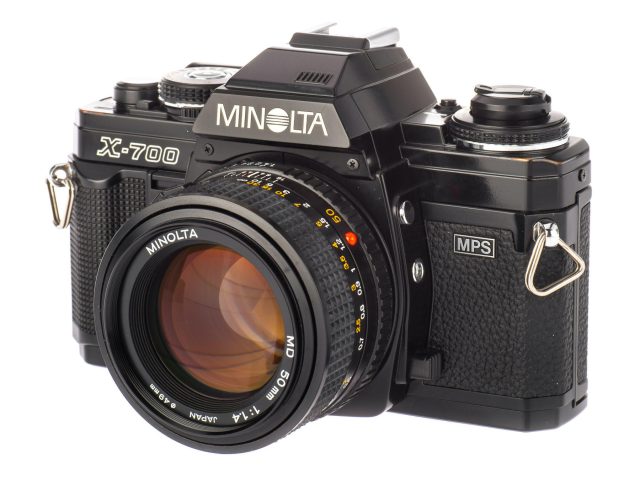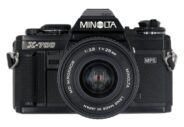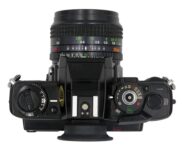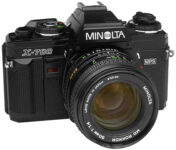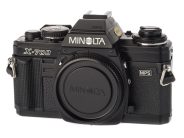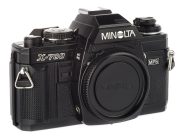Announced
Production status
System
Minolta SR system cameras
- Minolta SR-1
- Minolta SR-1s
- Minolta SR-2
- Minolta SR-3
- Minolta SR-7
- Minolta SRM
- Minolta SRT100
- Minolta SRT101
- Minolta SRT102
- Minolta SRT200
- Minolta SRT200 (II)
- Minolta SRT201
- Minolta SRT201 (II)
- Minolta SRT202
- Minolta SRT202 (II)
- Minolta SRTMC
- Minolta SRTMC-II
- Minolta SRTSC
- Minolta SRTSC-II
- Minolta X-370
- Minolta X-370N
- Minolta X-370s
- Minolta X-570
- Minolta X-600
- Minolta X-7
- Minolta X-700
- Minolta X-7A
- Minolta X-9
- Minolta XD-S
- Minolta XD11
- Minolta XD5
- Minolta XE
- Minolta XE-5
- Minolta XG 9
- Minolta XG-1
- Minolta XG-1(n)
- Minolta XG-A
- Minolta XG-M
- Minolta XG-SE
- Minolta XG7
- Minolta XK
- Minolta XK MOTOR
Minolta X-700
35mm MF film SLR camera • Discontinued
Specification
| Format: | |
| 35mm full frame | |
Film type: | 135 cartridge-loaded film |
| Minolta SR [43.5mm] | |
| Shutter: | |
Type: | Focal-plane |
Model: | Electronically controlled |
Speeds: | 4 - 1/1000 + B |
| Exposure: | |
Exposure metering: | Through-the-lens (TTL), open-aperture |
Exposure modes: | Programmed Auto |
| Aperture-priority Auto | |
| Manual | |
| Physical characteristics: | |
Weight: | 505g |
Dimensions: | 137x89x51.5mm |
Manufacturer description #1
Your Minolta X-700, the state-of-the-art SLR camera at the center of the Minolta Program System, offers you the focus-and-shoot simplicity of programmed auto-exposure (AE) control: Both aperture and shutter speed are automatically set over a wide range by the camera, with continuous viewfinder LED readout of speeds being set. The program is designed to maintain fastest practicable speeds as light dims, then give audible beeps, if desired, to guard against blur from subject/camera-movement, making the X-700 ideal if you're starting out in photography or if you want full program automation for ease of use or fast-breaking action.
The X-700's aperture-priority AE mode lets you control the depth of field but still maintain AE control of stepless shutter speeds fine-tuned for proper exposure with light metered up to the instant of exposure. This mode is excellent for AE photography with the wide range of Minolta SLR system lenses and accessories available, including mirror lenses and close-up bellows - not possible with shutter-priority AE systems. For full creative flexibility, aperture and shutter can be set independently in any combination in the X-700's metered/full-manual mode.
Other handy features of your X-700 include: touch-switch metering that keeps the LEDs on for 15 seconds after you first touch the operating button: AE lock for holding adjusted-framing meter readings; +/-2EV stops' exposure adjustment with LED indicator in finder; self-timer with triple-rate visual/audible indications; flash-ready and Flash Distance Checker (FDC) indications in finder; split-image microprism spot and Acute Matte focusing screen; integral front and back grips for surer holding; Safe Load Signal; and a new easy-load take-up spool.
A programmed autoflash, multi-function back, and quartz data back complete the Minolta Program System; also available are a new wireless controller, a motor drive and auto winder, and a broad range of other SLR system accessories.
Manufacturer description #2
TYPE: Electronically governed 35mm single-lens reflex AE camera
EXPOSURE-CONTROL MODES: Fully programmed ("P"), aperture-priority automatic ("A") and metered manual ("M")
LENS MOUNT: Minolta SLR bayonet of integrally libricated stainless steel (54 deg. rotation angle); coupling for full-aperture metering, finder display input, and automatic diaphragm control, providing programmed or aperture-priority auto operation with Minolta MD lenses, aperture-priority auto operation with MC and other Minolta SLR interchangeable lenses/accessories; spring-return button for depth-of-field preview or stop-down meter reading with other than MD and MC lenses (standard lenses: MD 50mm f/1.2, f/1.4 or f/1.7)
EXPOSURE CONTROL AND FUNCTIONS: Low-voltage, low-current computer circuit (incorporating quartz crystal for sequential control to 1/30,000 sec. accuracy, large scale ICs, samarium-cobalt impulse-release magnets, and linear-resistance inputs) varies both aperture and shutter speed steplessly according to special "faster-speed" program in P mode, or varies shutter speed steplessly according to aperture set in A mode, to yield proper exposure for the film speed and exposure adustment set; auto-exposure range: EV 1 to EV 18 at ISO 100/21 deg. with f/1.4 lens; AE lock device holds meter reading for exposure at that value regardless of subject-brightness changes
SHUTTER: Horizontal-traverse focal-plane type; electronically controlled stepless speeds 1/1000 to 4 sec. set automatically with endlessly rotatable selector dial locked at "P" or "A" setting or fixed speeds 1 to 1/1000 sec. or "B" (bulb) set manually at detented dial indications; electromagnetic shutter release locks when voltage too low for proper operation
METERING: TTL center-weighted averaging type, by silicon photocell mounted at rear of pentaprism for available light, measured full aperture for normal finder display, then at taking aperture for programmed/automatic-exposure setting/determination or stop-down display; by another SPC mounted with optic in side of mirror compartment for TTL off-film Direct Autoflash Metering at taking aperture during exposure to control burst duration of PX-series flash units
FILM-SPEED RANGE: ISO 25/15 deg. to 1600/33 deg. set by ASA dial that locks at 1/3-EV increments
EXPOSURE-ADJUSTMENT CONTROL: Up to +/-2 EV continuous adjustment of P, A, or M exposure by dial that locks at zero position and each 1/2-EV setting
MIRROR: Triple-coated oversize instant-return slide-up type
VIEWFINDER: Eye-level fixed pentaprism type showing 95% of 24x36mm film-frame area; magnification: 0.9X with 50mm standard lens focused at infinity; power: -1D, adjustable with accessory snap-on eyepiece lenses; Fresnel-field focusing screen having artificially regular-patterned matte field plus central split-image horizontally oriented focusing aid surrounded by microprism band, interchangeable with Type P1, P2, Pd, M, G, L, S, or H screens at authorized Minolta service stations; visible around frame: mode indication ("P", "A" or "M"), shutter speed scale (1, 2, 4, 8, 15, 30, 60, 125, 250, 500, and 1000) with LED setting indication, triangular over-/under-range LED indicators blinking at 4 Hz, flash-ready signal (LED next to "60" blinking at 2 Hz), FDC signal ("60" LED blinking at 8 Hz for 1 sec. after correct flash exposure), mis-set lens warning (mode indication blinking at 4 Hz) in P mode, battery check (by glowing of any LED when operating button touched or pressed slightly), f-number set with MD or MC lenses, and exposure-adjustment engaged indication (LED blinking at 4 Hz); display and metering activated by normal finger contact or slight pressing of operating button and continue for 15 sec., except go out after shutter release
FLASH SYNC AND CONTROL: Hot shoe and PC terminal for X sync; camera-control contact on hot shoe for flash-ready signaling and automatic setting of shutter at 1/60 sec. (except when mode/shutter-speed selector set for sync at "B") with PX and X flash units; other electronic units synchronize at 1/60 sec. and slower manual speeds or "B" setting; class MF, M, and FP flashbulbs, at 1/15 sec. or slower setting: second contact on hot shoe for burst control by Direct Autoflash Metering with PX units
FILM ADVANCE: Manual: by lever with single 130 deg. stroke after 30 deg. unengaged movement; motorized: through built-in coupler key with accessory Motor Drive 1 or Auto Winder G; release button for rewind on camera bottom; advancing-type frame counter; Safe Load Signal indicating film loading and advancing condition
POWER: Two 1.5v alkaline-manganese (LR44: Eveready A-76 or equiv.), two 1.55v silver-oxide (SR44: Eveready S-76, EPX-76 or equiv.), or one 3v lithium (CR-1/3N) cell(s) contained in camera base power both programmed/auto exposure control and manual operation; three-position main switch with indication for off, on, or on with audible piezoelectric slow-speed warning and self-timer operating indication; battery check by touching or slightly pressing operating button (LEDs do not light when cells approach exhaustion); shutter will not release when voltage too low for proper operation
SELF-TIMER: Electronic for 10-sec. delay, with operation indicated by camera-front LED that blinks at 2 Hz for 8 sec., then 8 Hz for 1 sec., then remains on until shutter releases, plus simultaneous audible indication when main switch in appropriate position; engaged by switch on body, cycle started by pushing operating button, cancelable anytime before release
OTHER: Audible 4 Hz piezoelectric warning when finder speed indication is 1/30 sec. or slower whenever finger contacts "touch switch" normally or presses operating button slightly with main switch approproately set; integral front handgrip; detachable back with integral handgrip, memo holder, and ISO (DIN-ASA) table; positive 4-slot take-up spool; remote shutter-release socket
